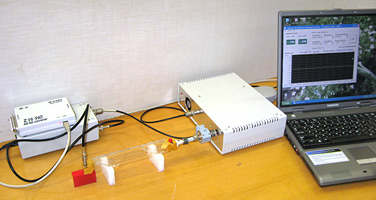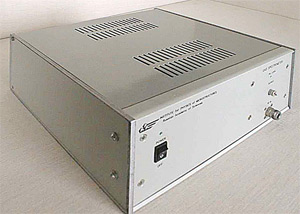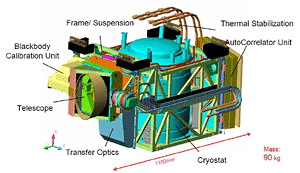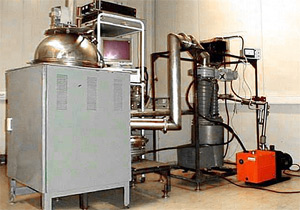Design and development of nonstationary THz spectrometers
The essence of a nonstationary spectroscopy is as following: interaction of electromagnetic radiation with ensemble of absorbing molecules results in induction of macroscopic dipole. After a radiation impact is over, absorbed energy is reradiated coherently at the frequency of molecular transition. The operation of nonstationary spectrometers can be realized in a phase switching or fast passage regime.
 Phase-switching spectrometer based on BWO
Phase-switching spectrometer based on BWO
| Frequency range |
118-178 GHz (can be broaded up to 37-720 GHz) |
| Sensitivity with absorption cell length = 1 m and averaging time = 1 s | 5×10-10 cm-1 |
| Minimal measurement time resolution | 1×10-6 s |
| Accuracy of the absorption line intensively (without preliminary calibration) | ≤ 5% |
| Microwave frequency accuracy | 10-9 |
| Microwave radiation power | ≥ 10mW |
 Phase-switching spectrometer based on solid state generator
Phase-switching spectrometer based on solid state generator
| Frequency range |
1-2.8 THz |
| Frequency set accuracy | 10-9 |
| Frequency range of the Gunn oscillator | 97.5-117.5 GHz |
| Instrumental linewidth of generation | < 10 kHz |
| 5×10-7 cm-1 | |
| Min. time of measurement | 1×10-6 s |
| Accuracy of measuring the intensity of absorption line | ≤ 10% |
 Fast scan fourier-transform spectrometer with frequency-locked BWO
Fast scan fourier-transform spectrometer with frequency-locked BWO
| Frequency range |
37-180 GHz |
| Ramp ratio | 105-107MHz/s |
| Single scan range | 10-1000 MHz |
| Time of the scan | 0.01-1 ms |
| Resolution | Sub-Doppler |
| Sensitivity (l = 1 m, Tmeas/Npoint = 1 ms) | ~ 10-8 cm-1 |
The integrated spectrometer based on SIS-mixer and FFO oscillator
Together with IRE RAS (Moscow) and SRON (Netherlands) we elaborated a high-sensitive spectrometer for registration of atmospheric gases in the framework of the ТELIS (TErahertz and sub-millimeter Limb Sounder) project. It was a new remote sensing instrument measuring atmospheric trace gases from a stratospheric balloon platform in the submillimeter and far infrared spectral region. On March, 11th, 0:18 local time a 400.000 m3 helium balloon was launched in Kiruna / Sweden for a 12 hour flight reaching a maximum altitude of 36 km.
 |
 |
| FFO Frequency, GHz | Substances (High priority) |
| 495.04 | H218O |
| 496.88 | HDO |
| 505.6 | BrO (ΔТ = 0.3 К !!) |
| 507.28 | ClO |
| 515.25 | O2 |
| 519.25 | BrO (ΔТ = 0.3 К !!) |
| 607.78 | O3 isotopes |
| 619.1 | HCl (HOCl, ClO) |
 Phase-switching spectrometer combined with supersonic molecular beams technique
Phase-switching spectrometer combined with supersonic molecular beams technique
We propose an approach to increase a sensitivity of microwave and THz spectroscopy, that involves application of supersonic molecular beams. The key advantage offered by such an approach is that a gas temperature can be decreased along with an increase in the gas density, which results in a much greater number of molecules interacting with radiation and, hence, in a higher absorption coefficient. This effect has been demonstrated experimentally on supersonic CO and NO beams, using a phase manipulation microwave spectrometer. The absorption coefficient was found to be three orders of magnitude higher than the value of gas absorption coefficient in a standard 1-m long cell at room temperature.
| Mixture | Gain in absorption coefficient (experiment) | Gain in absorption coefficient (theory) |
|---|---|---|
| NO (10% argon mixture) | 1.3×103 | 9×102 |
|
CO (0.1% mixture) |
1.2×103 | 1.5×103 |
| CO (0.3% mixture) | 1.5×103 | |
| CO (3% mixture) | 1.5×103 |
Our devices were delivered to many scientific centers all over the world: Technical faculty of St. Albrecht University, Kiel, Germany; Insight Product Company, Newton, USA; Chalmers University, Gothenburg, Sweden; Texas A&M University, USA; University, Tokio, Japan; Justus Liebig University, Giessen, Germany.


